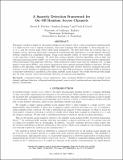A Sparsity Detection Framework for On–Off Random Access Channels
Author(s)
Fletcher, Alyson K.; Rangan, Sundeep; Goyal, Vivek K.
DownloadFletcher-2009-A sparsity detection framework for on-off random access channels.pdf (270.0Kb)
PUBLISHER_POLICY
Publisher Policy
Article is made available in accordance with the publisher's policy and may be subject to US copyright law. Please refer to the publisher's site for terms of use.
Terms of use
Metadata
Show full item recordAbstract
This paper considers a simple on-off random multiple access channel, where n users communicate simultaneously to a single receiver over m degrees of freedom. Each user transmits with probability lambda, where typically lambdan<m(symbol)n, and the receiver must detect which users transmitted. We show that when the codebook has i.i.d. Gaussian entries, detecting which users transmitted is mathematically equivalent to a certain sparsity detection problem considered in compressed sensing. Using recent sparsity results, we derive upper and lower bounds on the capacities of these channels. We show that common sparsity detection algorithms, such as lasso and orthogonal matching pursuit (OMP), can be used as tractable multiuser detection schemes and have significantly better performance than single-user detection. These methods do achieve some near-far resistance but-at high signal-to-noise ratios (SNRs) - may achieve capacities far below optimal maximum likelihood detection. We then present a new algorithm, called sequential OMP, that illustrates that iterative detection combined with power ordering or power shaping can significantly improve the high SNR performance. Sequential OMP is analogous to successive interference cancellation in the classic multiple access channel. Our results thereby provide insight into the roles of power control and multiuser detection on random-access signaling.
Date issued
2009-09Department
Massachusetts Institute of Technology. Department of Electrical Engineering and Computer Science; Massachusetts Institute of Technology. Research Laboratory of ElectronicsJournal
Proceedings of SPIE--the International Society for Optical Engineering
Publisher
Society of Photo-optical Instrumentation Engineers
Citation
Fletcher, Alyson K., Sundeep Rangan, and Vivek K. Goyal. “A sparsity detection framework for on-off random access channels.” Wavelets XIII. Ed. Vivek K. Goyal, Manos Papadakis, & Dimitri Van De Ville. San Diego, CA, USA: SPIE, 2009. 744607-15. © 2009 SPIE
Version: Final published version
ISSN
0277-786X